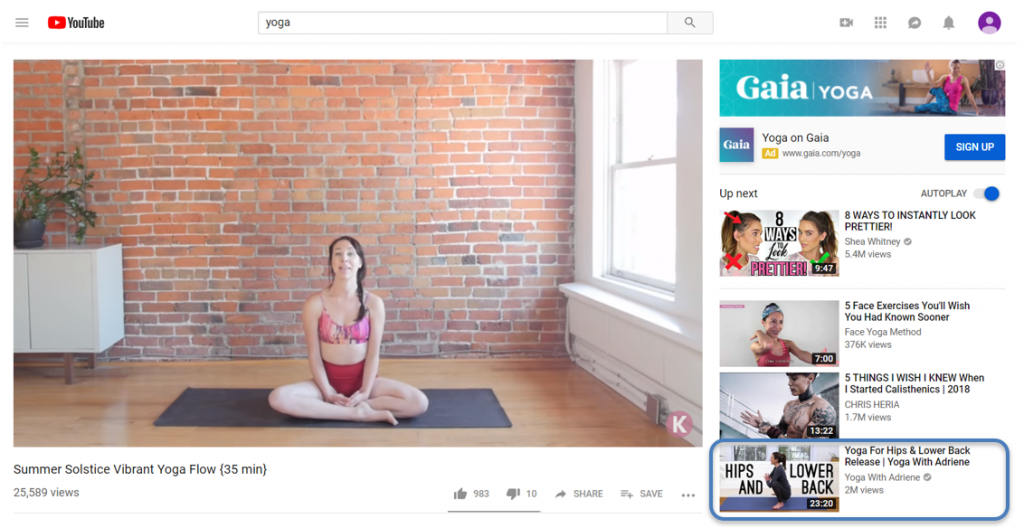YouTube was founded in February 2005, almost one year after the founding of Facebook, a year-and-a-half after Myspace, and more than two years before Twitter. A year later, it was the fastest-growing website. By 2006, it garnered more than 65,000 video uploads and 100 million page views every day. By 2015, over 400 hours’ worth of video were uploaded every minute.
By the time Google came calling and purchased the platform in October 2006, YouTube estimated they were making $15 million per month from ad revenue — and after the acquisition, Google began further YouTube monetization: they started the YouTube Partners program the next year to help grow and monetize high-activity channels, and rolled out video advertising.
While the early days of YouTube were dominated by short, low-quality videos, YouTube has since then favored longer form content to keep viewers watching for greater periods of time. Around 2010, they implemented a handful of features to nudge things in that direction. Among these were video rentals, which provided viewers the ability to rent certain feature-length pieces, and a live-streaming platform. But the most ubiquitous of these features is the mid-video ads — up to 20 seconds long — that advertisers can feature as an intermission during a video over 10 minutes long.
As YouTube increased potential for advertisers’ monetization and brand awareness, different niche markets began to pop up. Once it was clear those niches gained devoted followers and were here to stay, the site institutionalized new features like YouTube Kids, YouTube Gaming, YouTube Music, and YouTube Red, the latter being a subscription service that allows for ad-free content and offline viewing.
Which bring us to how YouTube can help grow your business.
For one, you can all but guarantee your audience is there. YouTube has more site visits than any other website in the world other than Google, and 80 percent of adults under 50 watch videos on YouTube in any given month. Furthermore, TV viewership continues to decline as cable costs become less affordable, especially for millennials, while YouTube’s more than one billion users have the ever-growing potential to generate high traffic volumes.
Having YouTube-based content boosts your search engine visibility through several advantages.
1. Google Indexing
Google indexes YouTube videos within its own search results. This creates more opportunities for your video content to rank within Google search results. Higher ranking means greater positioning, and greater positioning means greater traffic volume.
Regardless of content (although, quality content matters… more on that later), just the act of having a YouTube presence improves your search engine optimization.

For YouTube channel Yoga With Adriene, here is an example of her videos in the Google search results.
2. Building Backlinks
This is similar to the philosophy of creating content via a blog or other written media, just in video form. Once you have videos on YouTube, you can embed them on your site and, by hosting these videos, earn quality backlinks from others within your industry who find your content engaging and compelling. Compared to a site not producing content, you’re essentially giving users more reasons to visit you. When other relevant sites link to your content, it not only helps grow inbound traffic to your website, it helps increase your domain authority and subsequent search engine ranking.

For Yoga With Adriene, here is an example of her video embedded in an article by Mashable.
3. Reducing Bounce Rate
It’s one thing to get traffic to your website that hangs around for two seconds, doesn’t click on anything, and then leaves. By creating quality YouTube content and hosting it on your site, you can keep visitors interested and present for longer. A relevant video will keep visitors both on your site and better engaged — and a more engaged user will stay longer and be more likely to return and interact again.
4. Earn High Video Suggestion Rankings
While this isn’t the guaranteed outcome for all videos, a high-quality video that’s relevant and optimized carries the possibility of Google ranking it under their suggested videos. When this happens, Google will usually display it below their featured snippets but above their top organic results. If your video is high-quality enough to warrant this treatment, it can gain increased traffic and better brand visibility.

For Yoga With Adriene, here is an example of her video in the suggested videos section.
Now that you know the advantages to producing and hosting YouTube content, it’s important to consider the categories in which YouTube ranks videos, plus optimization tactics to ensure your content is well-positioned.
YouTube Ranking Categories
There are a few different filters through which YouTube videos are sorted, distinguished, and ranked. Knowing these can help you optimize your video content to ensure they’re positioned as high as possible in the most relevant searches.
Here are the main categorical ranking factors to keep in mind when creating, naming, editing, and marketing your video content on the YouTube platform:
1. Video Content Factors
There are number factors for your videos that play into how it’s ranked — probably more than any other categories. This includes the name of the video file, the title, keywords in the description, and any tags that you include on it. While the file and video titles are self-explanatory, the description and tags work together to capture relevant searchers. Although using the right keywords in your description is important, in the end the description is a blurb meant to inform and hook viewers. Sometimes it is not possible to include all the relevant keywords into a description without it reading unnaturally. In these cases, you can use the tags to include keywords that apply to your video but couldn’t fit in the description.
For example, for a video of a live comedy performance, an ideal description would be a brief blurb naming the comedian, the venue and show, and quickly foreshadowing the topics covered to pique a potential viewer’s interest. However, that likely doesn’t include many of the keywords relevant users would search, including the broader topics in the set, other well-known comedians on the show, or just the general topic (say, “comedy” or “funny”) and format (“stand-up,” “improv,” or “sketch,” for example) under which the video falls.

For Yoga With Adriene, here is an example of her video with the title, description, and tags.
Other factors within the content umbrella that determine ranking include video transcription or closed captioning, video “freshness,” and its length.
2. Channel Factors
Besides the content of the video itself, videos are also ranked in searches based on the channel from which they originate. Some of these correspond to the video content factors on a larger scale, like the channel title or description. Others, however, are unique to the channel category.
This includes factors like a channel’s age, total number of subscribers and views, and frequency of video uploads. If a user is searching for videos on a given topic (and of course there’s loads of channels that cover that topic), a channel that has a million views and 1,000 subscribers will have a higher positioning than one with 1,000 views and 12 subscribers. Similarly, a channel that uploads once a week will show up higher than one that uploads once every three months.
For the latter, not only will a channel that uploads frequently earn a better search engine ranking, but its consistent content production will return viewers, because they know when and how often content is being published. These viewers increase views, which increase subscriptions, which increase — you guessed it — the search engine ranking of your videos.

For Yoga With Adriene, here is an example of her channel with the number of subscribers, date joined, and number of views.
3. User Action Factors
Unlike the first two categories, the user action factors involve less of your own brand’s control over its channels and videos. Qualitative factors that you control (tags, descriptive keywords, etc.) notwithstanding, the factors that come into play with your channel and video’s ranking are pretty much binary — by any user, your video has been either viewed, or not. Any user has either subscribed to your channel, or they haven’t. The user action factors, however, have much more grey area and factors that you as a creator have little control over.
There’s still plenty of quantitative metrics that affect your video’s ranking, such as the number of comments, number of followers originating from your video, and audience retention on your channel. But the other ones include thumbs up/thumbs down votes, comment keywords, and comment reactions. Not only are the latter factors qualitative, but even the former — all metrically inclined — include active user engagement.
4. Recommendation Factors
The recommendation factors involve how your video fits in with a user’s previously demonstrated YouTube “tastes.” If a user’s video watching history suggests they’re likely to be interested in your content too, then your content will be positioned higher in searches. Similarly, if a user has many favorited videos that are similar to your content, then your content is more likely to be recommended by YouTube and show up higher in recommended videos.
We hope this blog helps you better understand the advantages of using YouTube to increase your search engine positioning, plus the factors that determine your videos’ rankings. Stay tuned for a follow-up piece that will focus on optimizing your video content based on the factors discussed, and how to analyze your YouTube metrics.




